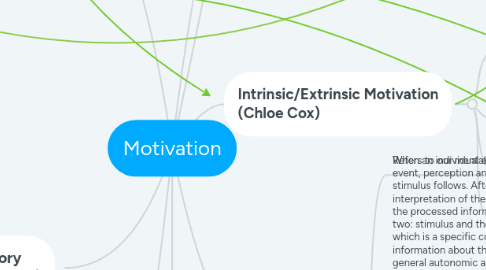
1. Carol Dweck's Mindset Theory
1.1. Growth Mindset: "I can't do it...YET."
1.2. Static/Fixed Mindset: I can't do it.
2. Weiner's Attribution Theory
2.1. To whom or to what do students attribute their successes and failures?
2.2. Vocab: Locus (location), Internal (disposition), External (situational). Stability (likelihood of change), Stable, Unstable. Control (power), Controllable, Uncontrollable
3. Self Efficacy, Expectancy Theory, and Learned Helplessness (Spencer Durrant)
3.1. Albert Bandura - Self Efficacy: Main Idea: Reflects confidence in the ability to control one's motivation
3.2. Victor Vroom - Expectancy Theory: Main Idea: An individual will behave or act in a certain way because they are motivated to select a specific behavior over others due to what they expect the result of that selected behavior will be.
3.3. Martin Seligman - Learned Helplessness: Learned helplessness occurs when a person is repeatedly subjected to an aversive stimulus that it cannot escape. Eventually, the person will stop trying to avoid the stimulus and behave as if it is utterly helpless to change the situation. Vocab - aversive stimulus: an unpleasant event that is intended to decrease the probability of a behavior when it is presented as a consequence
4. Edward Locke's Goal Theory (Channing Hyde & Austin Lush)
4.1. Edward Locke
4.1.1. 1960s
4.2. Basics:
4.2.1. specific & clear; realistic & challenging; appropriate/ongoing feedback; effort/commitment
4.3. Variables:
4.3.1. Mastery Goals
4.3.1.1. mastering a task; learning; understanding; avoid misunderstanding; avoid incorrect mastery
4.3.2. Performance Goals
4.3.2.1. being the best in comparison to others; relative ability; ego-involved; avoid looking dumb
4.3.3. Outcomes
4.4. Strengths: Empirical research; ease of use; broadly applicable; self-efficiency; goal commitment; feedback; measurable assessing
4.5. Weaknesses: Conflicting goals; may not work well w/ complex situation; self-assessment may not be realistic; need for accurate assessment; does it satisfy participant?; too much pressure?
5. We are innately curious and we have a love of learning.
5.1. Fun
5.1.1. Relatedness
6. Maslow's Hierarchy of Needs (Kaylie Grant)
6.1. Three basic types of needs: Basic, Psychological and Self-fulfillment
6.2. 6 categories of needs: (Basic needs): Physiological and Safety needs. (Pyschological needs): Belonging/Love and Esteem needs. (Self Fulfillment): Self Actualization.
6.3. Physiological Needs: Food, water, warmth, rest. (Free/reduced lunch, bathroom/drink breaks)
6.4. Safety Needs: Security, Safety. (Controlled classroom behavior, fair discipline)
6.5. Belonging/Love Needs: Close relationships, friends. (teacher conferencing, genuinely listening to students)
6.6. Esteem Needs: Feeling of Accomplishment. (Focusing on student strengths, "star of the week")
7. Intrinsic/Extrinsic Motivation (Chloe Cox)
7.1. Extrinsic: perform a behavior or engage in an activity to earn a reward or avoid punishment.
7.1.1. External rewards can induce interest and motivate acquiring new skills that can then become intrinsically motivating.
7.1.2. External rewards are not useful if it is already intrinsically rewarding. Offering a reward might turn “play” into “work”
7.2. Intrinsic: personally rewarding, the behavior itself is the reward.
7.2.1. If a reward boosts your feeling of competence after doing good work your intrinsic enjoyment of the task may increase.
7.3. Interests
7.3.1. Individual interest: connecting to a student’s life; sports, movies, pop culture.
7.3.2. Situational interest: engaging in a new activity in class lesson.
7.4. Flow: state of mind where we enjoy what we are doing; time flies; when we are challenged and/or having fun.
8. Ryan and Deci's Self-Determination Theory (Sarah Hicken)
8.1. 3 Basic Needs: Autonomy, Competence, Relatedness.
8.1.1. Relatedness: Sense of belonging, feeling like you matter to others, feeling cared for and connected to others.
8.1.2. Competence: Mastery of things important to you.
8.1.3. Autonomy: Essential to wellness.

